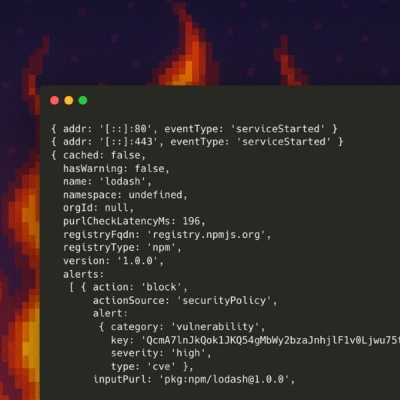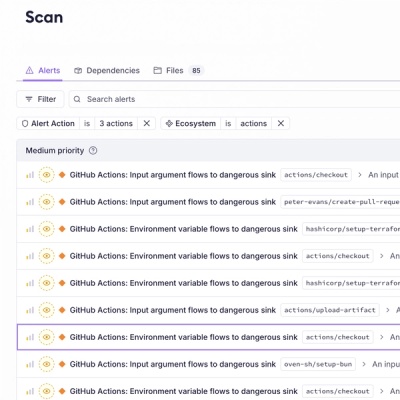
Product
Introducing Socket Firewall Enterprise: Flexible, Configurable Protection for Modern Package Ecosystems
Socket Firewall Enterprise is now available with flexible deployment, configurable policies, and expanded language support.
@ag.common/app-layout
Advanced tools
Common application shell for apps in the user-facing authenticated space of the Export Service
Common application shell for apps in the user-facing authenticated space of the Export Service
yarn add @ag.common/app-layout
import { AppLayout } from '@ag.common/app-layout';
import { useAuthentication } from '@ag.common/auth';
import { useBusinessDetails } from '@ag.common/auth';
import { useRouter } from 'next/router';
function App() {
const router = useRouter();
const businessDetails = useBusinessDetails();
return (
<AppLayout activePath={router.asPath} businessDetails={businessDetails}>
<YourApplication />
</AppLayout>
);
}
It may make sense for your application to start from its root when a user changes context.
import { AppLayout } from '@ag.common/app-layout';
import { useAuthentication } from '@ag.common/auth';
import { useBusinessDetails } from '@ag.common/auth';
import { useRouter } from 'next/router';
function App() {
const router = useRouter();
const businessDetails = useBusinessDetails();
const onBusinessSelected = (business: Business) => {
businessDetails.setSelectedBusiness(business);
router.push('/your-app-base-path-here');
};
return (
<AppLayout
activePath={router.asPath}
businessDetails={{
...businessDetails,
setSelectedBusiness: onBusinessSelected,
}}
>
<YourApplication />
</AppLayout>
);
}
You may want to interrupt a user before allowing them to change their selected business if they have pending changes.
import { AppLayout } from '@ag.common/app-layout';
import { useAuthentication } from '@ag.common/auth';
import { useBusinessDetails } from '@ag.common/auth';
import { useRouter } from 'next/router';
function App() {
const router = useRouter();
const businessDetails = useBusinessDetails();
const [targetBusiness, setTargetBusiness] = useState<Business | undefined>();
return (
<AppLayout
activePath={router.asPath}
businessDetails={{
...businessDetails,
setSelectedBusiness: (business: Business) => {
setTargetBusiness(business);
},
}}
>
<Modal
isOpen={targetBusiness !== undefined}
onClose={setTargetBusiness(undefined)}
title="Are you sure you want to leave this page?"
actions={
<ButtonGroup>
<Button
onClick={() => {
businessDetails.setSelectedBusiness(targetBusiness);
setTargetBusiness(undefined);
}}
>
Leave this page
</Button>
<Button variant="secondary" onClick={setTargetBusiness(undefined)}>
Stay on this page
</Button>
</ButtonGroup>
}
>
<Text as="p">You will lose all changes made since your last save.</Text>
</Modal>
<YourApplication />
</AppLayout>
);
}
Your app may not handle single-named users. If you want to block these users from your app, pass through the auth claims and the app layout will display a helpful message instead.
import { AppLayout } from '@ag.common/app-layout';
import { authService } from '@ag.common/auth';
import { useRouter } from 'next/router';
function App() {
const router = useRouter();
const claims = authService.getAccountInfo()?.idTokenClaims;
return (
<AppLayout activePath={router.asPath} claims={claims}>
<YourApplication />
</AppLayout>
);
}
You can provide your own error message or handle analytics by providing a component that overrides the default.
import { AppLayout } from '@ag.common/app-layout';
import { authService } from '@ag.common/auth';
import { useRouter } from 'next/router';
function App() {
const router = useRouter();
const claims = authService.getAccountInfo()?.idTokenClaims;
return (
<AppLayout
activePath={router.asPath}
claims={claims}
errorComponents={{
MissingGivenName: (props) => (
<Fragment>
<p>everything is fine, actually</p>
{props.children}
</Fragment>
),
}}
>
<YourApplication />
</AppLayout>
);
}
FAQs
Common application shell for apps in the user-facing authenticated space of the Export Service
We found that @ag.common/app-layout demonstrated a healthy version release cadence and project activity because the last version was released less than a year ago. It has 3 open source maintainers collaborating on the project.
Did you know?

Socket for GitHub automatically highlights issues in each pull request and monitors the health of all your open source dependencies. Discover the contents of your packages and block harmful activity before you install or update your dependencies.

Product
Socket Firewall Enterprise is now available with flexible deployment, configurable policies, and expanded language support.

Security News
Open source dashboard CNAPulse tracks CVE Numbering Authorities’ publishing activity, highlighting trends and transparency across the CVE ecosystem.

Product
Detect malware, unsafe data flows, and license issues in GitHub Actions with Socket’s new workflow scanning support.